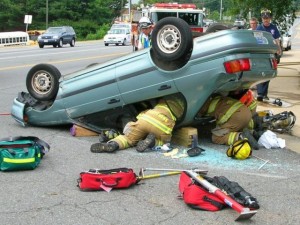How to get information about a motor vehicle accident
Consider hidden sources of information about an accident, particularly when there is a question of when it happened. 
- The cardiac monitor/defibrillator electrocardiogram (ECG) equipment used by an ambulance crew has an internal clock, which documents the time on the ECG rhythm strip. This equipment is typically inspected by the EMT every shift and tested to ensure it is properly functioning. Look at this equipment for an additional source of time when the cardiac monitor is utilized.
- Ambulances sometimes have built in clocks in both the patient’s and driver’s compartment. Many EMTs use one of these sources as their time of reference.
- Some ambulance companies use cameras when the siren is in operation, which scans both the road traveled and the patient compartment, in an event the ambulance is involved in a motor vehicle collision, while enroute to the hospital.
- Hospitals use cameras for security purposes at entrances, parking areas, and in the ambulance bay area, which denote time and day. Obtain camera footage by contacting the security supervisor of these agencies. The footage obtained should be the “raw” camera footage, 10-15 minutes prior to and after the event. The security supervisor must identify how the time on the footage was synchronized.
- Coordinated Medical Emergency Direction (CMED) centers are strategically placed communication centers that link ambulance communication to hospitals by way of a switchboard type system. CMED centers rely on a network of radio towers to capture either cell phone communication or a two-way radio transmission and connect either of them together with a hospital emergency department and/or physician. This allows the EMT in the ambulance or on scene to communicate directly to an emergency department physician or staff. Ambulance personnel are required to provide an entry notification to the receiving hospital by way of a CMED center which records communications and marks recordings using the Official U.S. Time
- All air medical unit radio transmissions are recorded using the Official U.S. Time.
- Closed-circuit cameras are frequently used in many large cities to monitor activities and to ensure homeland security. Traffic cameras capture major highways and dangerous intersections. These cameras are a potential source of evidence.
8. Geographic Information System (GIS) captures specific data and creates various maps by using such data. Obtain GIS images prior to visiting the actual scene. Establish an idea of the surrounding area and determine what equipment is required, prior to the site visit. GIS mapping images are easily created from a desktop computer and can be made by using free state government GIS web sites. Internet sites such as Google Earth™ or Google Maps™ may also be used to create GIS images (Google Earth™, 2010; Google Maps™, 2010). Both aerial views and street views can be made from these sources with relative clarity; however, caution should be used with these images because the image may not reflect the current environment, as it appeared on the date of the incident
9. Global Positioning System (GPS) is a navigation satellite system developed by the U. S. Department of Defense to determine an individual or vehicle’s current location, time, and speed. GPS devices are used to locate and track something or someone. Some ambulance dispatch centers have GPS devices mounted in every ambulance, that transmit back to the dispatcher a visual location of the ambulance on the dispatchers’ street map. This reference saves time in locating an ambulance closest to the scene of an incident. All GPS data are stored in an electronic file format in the computer located at the dispatch center.
10. Review any autopsy video or photograph images of the incident. Bystanders or the media may have taken pictures.
Modified from Tom Quail, Enhance your Investigations Using Technology, The Journal of Legal Nurse Consulting, Fall 2011
Watch the all new webinar: Powerful Discovery Tools through Technology Webinar, May 1, 2013 at 8 PM Eastern. Get the digital download if you cannot join us for the live call.
This program is for attorneys and legal nurse consultants. Get more details at www.patiyer.com/aaa
We know that attorneys may ask for cell phone records to determine if a driver was talking on the phone during a car crash. But there is so much more information available that may help or hinder an attorney’s case: recorders, cameras and more! Do you know what a 911 tape says about an incident? Do you know what can exonerate or snare an individual?
Tom Quail RN has performed many investigations using information from technology. He will unveil the secrets of the scores of data that is being collected right now. He’ll teach you how and why you should get it.
Find out more at www.patiyer.com/aaa
Leave a Comment